All the solutions provided in McGraw Hill My Math Grade 4 Answer Key PDF Chapter 9 Lesson 3 Use Models to Subtract Like Fractions will give you a clear idea of the concepts.
McGraw-Hill My Math Grade 4 Answer Key Chapter 9 Lesson 3 Use Models to Subtract Like Fractions
You can use models to subtract like fractions. Think of subtracting fractions as separating parts that refer to the same whole.
Build It
Brayden used \(\frac{4}{5}\) of his coins in the first two levels of a video game. He used \(\frac{1}{5}\) of his coins in the first level. What fraction of his coins did he use in the second level?
Find \(\frac{4}{5}\) – \(\frac{1}{5}\).
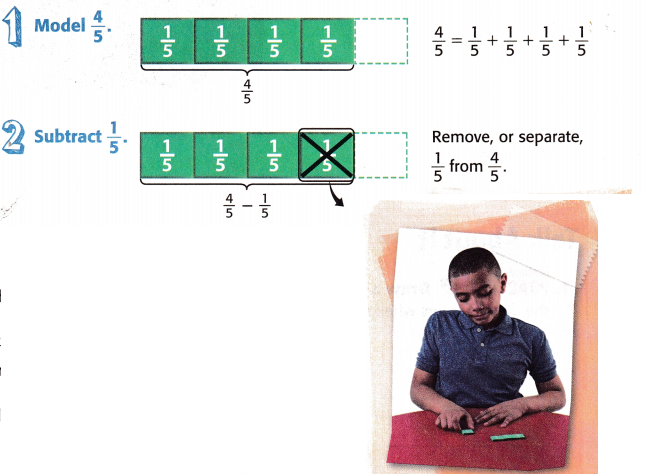
3. Count the total number of \(\frac{1}{5}\)-tiles that are left.
There are three \(\frac{1}{5}\)-fraction tiles left.
\(\frac{4}{5}\) – \(\frac{1}{5}\) = \(\frac{3}{5}\) So, Brayden used ![]() of his coins in the second level.
of his coins in the second level.
Check using addition. ![]() + \(\frac{1}{5}\) = \(\frac{4}{5}\)
+ \(\frac{1}{5}\) = \(\frac{4}{5}\)
Answer:
Fraction of his coins he used in the second level = \(\frac{3}{5}\)
Check using addition :  + \(\frac{1}{5}\) = \(\frac{4}{5}\)
+ \(\frac{1}{5}\) = \(\frac{4}{5}\)
Explanation:
Number of coins Brayden used in the first two levels of a video game = \(\frac{4}{5}\)
Number of coins Brayden used in the first level of a video game = \(\frac{1}{5}\)
Fraction of his coins he used in the second level = Number of coins Brayden used in the first two levels of a video game – Number of coins Brayden used in the first level of a video game
= \(\frac{4}{5}\) – \(\frac{1}{5}\)
= [(4 – 1) ÷ 5]
= \(\frac{3}{5}\)
Check:
Number of coins Brayden used in the first level of a video game + Fraction of his coins he used in the second level
= \(\frac{1}{5}\) + \(\frac{3}{5}\)
= [(1 + 3) ÷ 5]
= \(\frac{4}{5}\) = Number of coins Brayden used in the first two levels of a video game.
Try It
Find \(\frac{7}{8}\) – \(\frac{3}{8}\).
1. Model \(\frac{7}{8}\).
Notice that \(\frac{7}{8}\) is the sum of seven unit fractions of \(\frac{1}{8}\).

2. Subtract \(\frac{3}{8}\).
Notice that \(\frac{3}{8}\) is the sum of three unit fractions of \(\frac{1}{8}\).
3. Count the remaining \(\frac{1}{8}\)-tiles.
There are _______________ remaining \(\frac{1}{8}\)-tiles.
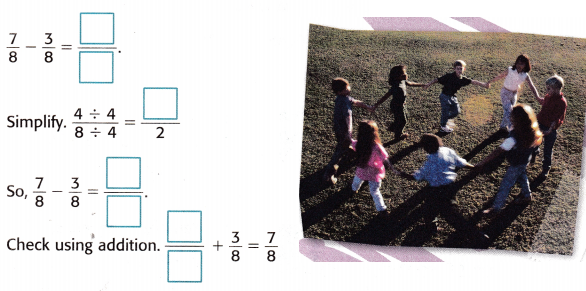
Answer:
\(\frac{7}{8}\) – \(\frac{3}{8}\) = \(\frac{1}{2}\)
Check:
 + \(\frac{3}{8}\) = \(\frac{7}{8}\)
+ \(\frac{3}{8}\) = \(\frac{7}{8}\)
Explanation:
Difference between \(\frac{7}{8}\) and \(\frac{3}{8}\):
\(\frac{7}{8}\) – \(\frac{3}{8}\)
= [(7 – 3) ÷ 8]
= \(\frac{4}{8}\) ÷ \(\frac{4}{4}\)
= \(\frac{1}{2}\)
Check:
\(\frac{3}{8}\) + \(\frac{1}{2}\)
=> [(3 ×1) + (1 × 4)] ÷ 8
= (3 + 4) ÷ 8
= 7 ÷ 8 or \(\frac{7}{8}\)
Talk About It
Question 1.
Mathematical PRACTICE Draw a Conclusion What do you notice about the denominators when subtracting like fractions?
Answer:
It is noticed that as the denominators are the same, we should only subtract the numerators.
Explanation:
Since the denominators are the same, subtract the numerators. You may get an answer which is not in lowest terms , even if the fractions you were adding and subtracting both were.
Practice It
Model the difference using fraction files. Then subtract.
Question 2.
\(\frac{4}{6}\) – \(\frac{3}{6}\) = _________________
Answer:
\(\frac{4}{6}\) – \(\frac{3}{6}\) = \(\frac{1}{6}\)
Explanation:
Difference between \(\frac{4}{6}\) – \(\frac{3}{6}\):
\(\frac{4}{6}\) – \(\frac{3}{6}\)
= [(4 – 3) ÷ 6]
= \(\frac{1}{6}\)

Question 3.
\(\frac{9}{12}\) – \(\frac{4}{12}\) = _________________
Answer:
\(\frac{9}{12}\) – \(\frac{4}{12}\) = \(\frac{5}{12}\)
Explanation:
Difference between \(\frac{9}{12}\) and \(\frac{4}{12}\):
\(\frac{9}{12}\) – \(\frac{4}{12}\)
= [(9 – 4) ÷ 12]
= \(\frac{5}{12}\)

Question 4.
\(\frac{6}{10}\) – \(\frac{3}{10}\) = _________________
Answer:
\(\frac{6}{10}\) – \(\frac{3}{10}\) = \(\frac{3}{10}\)
Explanation:
Difference between \(\frac{6}{10}\) and \(\frac{3}{10}\):
\(\frac{6}{10}\) – \(\frac{3}{10}\)
= [(6 – 3) ÷ 10]
= \(\frac{3}{10}\)
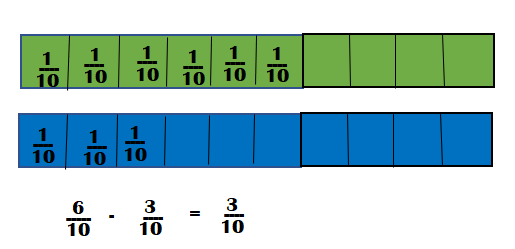
Question 5.
\(\frac{4}{5}\) – \(\frac{2}{5}\) = _________________
Answer:
\(\frac{4}{5}\) – \(\frac{2}{5}\) = \(\frac{2}{5}\)
Explanation:
Difference between \(\frac{4}{5}\) and \(\frac{2}{5}\):
\(\frac{4}{5}\) – \(\frac{2}{5}\)
= [ (4 – 2) ÷ 5]
= \(\frac{2}{5}\)

Use the table for Exercises 6 and 7.

Question 6.
The table shows the difference of several like ‘fractions. Study the pattern in the table. Write a rule that you can use to subtract like fractions without using models.
Answer:
A rule that can be used to subtract like fractions without using models is that they should have same denominators.
Explanation:
To add or subtract fractions they must have the same denominator (the bottom value). If the denominators are already the same then it is just a matter of either adding or subtracting the numerators (the top value).
Question 7.
Use your rule from Exercise 6 to find \(\frac{11}{12}\) – \(\frac{8}{12}\).
Answer:
Difference between \(\frac{11}{12}\) – \(\frac{8}{12}\) = \(\frac{1}{4}\)
Explanation:
Rule from Exercise 6: They are like fractions having same denominators.
\(\frac{11}{12}\) – \(\frac{8}{12}\)
= [(11 – 8) ÷ 12]
= \(\frac{3}{12}\) ÷ \(\frac{3}{3}\)
= \(\frac{1}{4}\)
Algebra Find each unknown.
Question 8.
\(\frac{2}{4}\) – \(\frac{1}{4}\) = y
y = _______________
Answer:
So, y = \(\frac{1}{4}\)
Explanation:
\(\frac{2}{4}\) – \(\frac{1}{4}\) = y
=> \(\frac{2}{4}\) – \(\frac{1}{4}\) = y
=> [(2 – 1) ÷ 4] = y
=> \(\frac{1}{4}\) = y
Question 9.
\(\frac{5}{8}\) – \(\frac{2}{8}\) = x
x = ________________
Answer:
So, x = \(\frac{3}{8}\)
Explanation:
\(\frac{5}{8}\) – \(\frac{2}{8}\) = x
=> \(\frac{5}{8}\) – \(\frac{2}{8}\) = x
=> [(5 – 2) ÷ 8] = x
=> \(\frac{3}{8}\) = x
Question 10.
\(\frac{1}{2}\) – \(\frac{1}{2}\) = t
t = _________________
Answer:
So, t = 0.
Explanation:
\(\frac{1}{2}\) – \(\frac{1}{2}\) = t
=> \(\frac{1}{2}\) – \(\frac{1}{2}\) = t
=> [(1 – 1) ÷ 2] = t
=> \(\frac{0}{2}\) = t
=> 0 = t.
Question 11.
\(\frac{5}{6}\) – \(\frac{4}{6}\) = s
s = _________________
Answer:
So, s = \(\frac{1}{6}\)
Explanation:
\(\frac{5}{6}\) – \(\frac{4}{6}\) = s
=> \(\frac{5}{6}\) – \(\frac{4}{6}\) = s
=> [(5 – 4) ÷ 6]
=> \(\frac{1}{6}\) = s
Apply It
Question 12.
Ann ate 2 slices of a pizza and Teresa ate 3 slices of the pizza. The pizza had 8 slices. What is the difference in the amount of pizza that they ate written as a fraction?

Answer:
Fraction of the difference in the amount of pizza that they ate = \(\frac{5}{8}\)
Explanation:
Number of slices of a pizza Ann ate = 2.
Number of slices of a pizza Teresa ate = 3.
Total number of slices of a pizza = 8.
Fraction of the difference in the amount of pizza that they ate = (Number of slices of a pizza Ann ate + Number of slices of a pizza Teresa ate) ÷ Total number of slices of a pizza
= [(2 + 3) ÷ 8]
= \(\frac{5}{8}\)
Question 13.
Mathematical PRACTICE Use Symbols Virginia had \(\frac{8}{12}\) of the pictures left on her memory card. Then she took off \(\frac{7}{12}\) of the pictures. What fraction of the pictures does she have left? Write art equation to solve.
Answer:
Fraction of the pictures does she have left = \(\frac{1}{12}\)
Explanation:
Number of the pictures left on her memory card Virginia had = \(\frac{8}{12}\)
Number of the pictures she took off of the pictures = \(\frac{7}{12}\)
Equation:
Fraction of the pictures does she have left = Number of the pictures left on her memory card Virginia had – Number of the pictures she took off of the pictures
= \(\frac{8}{12}\) – \(\frac{7}{12}\)
= [(8 – 7) ÷ 12]
= \(\frac{1}{12}\)
Question 14.
Mathematical PRACTICE Reason Draw a model to find the unknown.
\(\frac{4}{5}\) – \(\frac{1}{5}\) = ?
Answer:
\(\frac{4}{5}\) – \(\frac{1}{5}\) = \(\frac{3}{5}\)
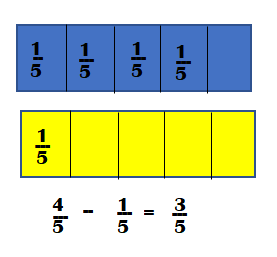
Explanation:
Difference between \(\frac{4}{5}\) and \(\frac{1}{5}\):
=>\(\frac{4}{5}\) – \(\frac{1}{5}\)
=> [(4 – 1) ÷ 5]
=> \(\frac{3}{5}\)
Write About It
Question 15.
How is subtracting like fractions similar to adding like fractions?
Answer:
To SUBTRACT fractions with like or the same denominator, just subtract the numerators then copy the common denominator just like addition.
Explanation:
When adding and subtracting fractions, the first thing to check is if the denominators are the same. If the denominators are the same, then it’s pretty easy: just add or subtract the numerators and write the result over the same denominator.
McGraw Hill My Math Grade 4 Chapter 9 Lesson 3 My Homework Answer Key
Practice
Model the difference using fraction tiles. Then subtract.
Question 1.
\(\frac{5}{6}\) – \(\frac{1}{6}\) = _______________
Answer:
\(\frac{5}{6}\) – \(\frac{1}{6}\) = \(\frac{4}{6}\) = \(\frac{2}{3}\)
Explanation:
Difference between \(\frac{5}{6}\) and \(\frac{1}{6}\):
\(\frac{5}{6}\) – \(\frac{1}{6}\)
= [(5 – 1) ÷ 6]
= \(\frac{4}{6}\) ÷ \(\frac{2}{2}\)
= \(\frac{2}{3}\)
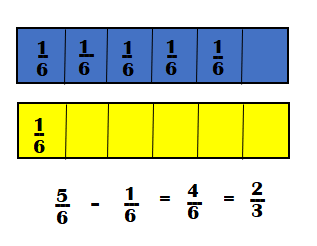
Question 2.
\(\frac{2}{3}\) – \(\frac{1}{3}\) = _______________
Answer:
\(\frac{2}{3}\) – \(\frac{1}{3}\) = \(\frac{1}{3}\)
Explanation:
Difference between \(\frac{2}{3}\) and \(\frac{1}{3}\):
\(\frac{2}{3}\) – \(\frac{1}{3}\)
= [(2 – 1) ÷ 3]
= \(\frac{1}{3}\)
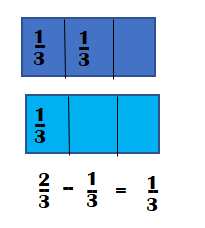
Question 3.
\(\frac{9}{10}\) – \(\frac{6}{10}\) = _______________
Answer:
\(\frac{9}{10}\) – \(\frac{6}{10}\) = \(\frac{3}{10}\)
Explanation:
Difference between \(\frac{9}{10}\) and \(\frac{6}{10}\):
\(\frac{9}{10}\) – \(\frac{6}{10}\)
= [(9 – 6) ÷ 10]
= \(\frac{3}{10}\)

Question 4.
\(\frac{6}{8}\) – \(\frac{4}{8}\) = _______________
Answer:
\(\frac{6}{8}\) – \(\frac{4}{8}\) = \(\frac{2}{8}\) = \(\frac{1}{4}\)
Explanation:
Difference between \(\frac{6}{8}\) and \(\frac{4}{8}\):
\(\frac{6}{8}\) – \(\frac{4}{8}\)
= [(6 – 4) ÷ 8]
= \(\frac{2}{8}\) ÷ \(\frac{2}{2}\)
= \(\frac{1}{4}\)
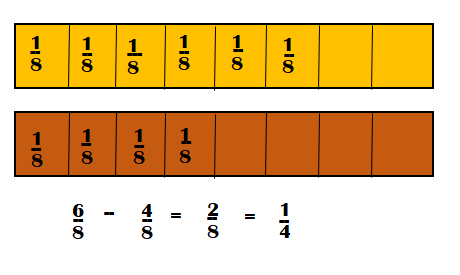
Algebra Write a subtraction equation for each model. Then subtract.
Question 5.

Answer:
\(\frac{2}{5}\) – \(\frac{1}{5}\) = \(\frac{1}{5}\)
Explanation:
Subtraction Equation:
\(\frac{2}{5}\) – \(\frac{1}{5}\)
= [(2 – 1) ÷ 5]
= \(\frac{1}{5}\)
Question 6.

Answer:
\(\frac{4}{10}\) – \(\frac{3}{10}\) = \(\frac{1}{10}\)
Explanation:
Subtraction Equation:
\(\frac{4}{10}\) – \(\frac{3}{10}\)
= [(4 – 3) ÷ 10]
= \(\frac{1}{10}\)
Question 7.

Answer:
\(\frac{1}{6}\) – \(\frac{4}{6}\) = –\(\frac{3}{10}\)
Explanation:
Subtraction Equation:
\(\frac{1}{6}\) – \(\frac{4}{6}\)
= [(1 – 4) ÷ 10]
= –\(\frac{3}{10}\)
Question 8.

Answer:
\(\frac{4}{10}\) – \(\frac{3}{10}\) = \(\frac{1}{10}\)
Explanation:
Subtraction Equation:
\(\frac{4}{10}\) – \(\frac{3}{10}\)
= [(4 – 3) ÷ 10]
= \(\frac{1}{10}\)
Problem Solving
Question 9.
For Friday night’s play performance, \(\frac{7}{8}\) of the theater was full. On Saturday night, the theater was only \(\frac{5}{8}\) full. How much more of the theater was filled on Friday night than on Saturday night? Write in simplest form.
Answer:
\(\frac{1}{4}\) more of the theater was filled on Friday night than on Saturday night.
Explanation:
Play performance of the theater on Friday night’s = \(\frac{7}{8}\)
Play performance of the theater on Saturday night’s = \(\frac{5}{8}\)
Difference:
Play performance of the theater on Friday night’s – Play performance of the theater on Saturday night’s
= \(\frac{7}{8}\) – \(\frac{5}{8}\)
= [(7 – 5) ÷ 8]
= \(\frac{2}{8}\) ÷ \(\frac{2}{2}\)
= \(\frac{1}{4}\)
Question 10.
Mathematical PRACTICE Use Number Sense Liam uses \(\frac{3}{4}\) of a cup of butter in his cookie recipe. Gloria uses \(\frac{2}{4}\) of a cup of butter in her cookie recipe. How much more butter does Liam use than Gloria?
Answer:
\(\frac{1}{4}\) more butter does Liam use than Gloria.
Explanation:
Number of cups of butter in his cookie recipe Liam uses = \(\frac{3}{4}\)
Number of cups of butter in his cookie recipe Gloria uses = \(\frac{2}{4}\)
Difference:
Number of cups of butter in his cookie recipe Liam uses – Number of cups of butter in his cookie recipe Gloria uses
= \(\frac{3}{4}\) – \(\frac{2}{4}\)
= [(3 – 2) ÷ 4]
= \(\frac{1}{4}\)